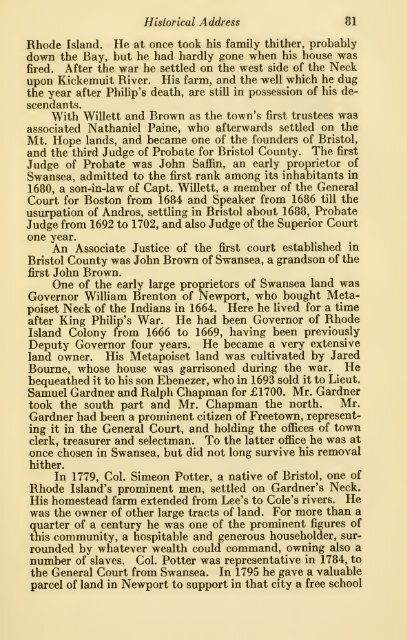History of Swansea, Massachusetts, 1667-1917; - citizen hylbom blog
History of Swansea, Massachusetts, 1667-1917; - citizen hylbom blog
History of Swansea, Massachusetts, 1667-1917; - citizen hylbom blog
You also want an ePaper? Increase the reach of your titles
YUMPU automatically turns print PDFs into web optimized ePapers that Google loves.
Historical Address 81<br />
Rhode Island. He at once took his family thither, probably<br />
down the Bay, but he had hardly gone when his house was<br />
fired. After the war he settled on the west side <strong>of</strong> the Neck<br />
upon Kickemuit River. His farm, and the well which he dug<br />
the year after PhiHp's death, are still in possession <strong>of</strong> his descendants.<br />
With Willett and Brown as the town's first trustees was<br />
associated Nathaniel Paine, who afterwards settled on the<br />
Mt. Hope lands, and became one <strong>of</strong> the founders <strong>of</strong> Bristol,<br />
and the third Judge <strong>of</strong> Probate for Bristol County. The first<br />
Judge <strong>of</strong> Probate was John Saffin, an early proprietor <strong>of</strong><br />
<strong>Swansea</strong>, admitted to the first rank among its inhabitants in<br />
1680, a son-in-law <strong>of</strong> Capt. Willett, a member <strong>of</strong> the General<br />
Court for Boston from 1684 and Speaker from 1686 till the<br />
usurpation <strong>of</strong> Andros, settling in Bristol about 1688, Probate<br />
Judge from 1692 to 1702, and also Judge <strong>of</strong> the Superior Court<br />
one year.<br />
An Associate Justice <strong>of</strong> the first court established in<br />
Bristol County was John Brown <strong>of</strong> <strong>Swansea</strong>, a grandson <strong>of</strong> the<br />
first John Brown.<br />
One <strong>of</strong> the early large proprietors <strong>of</strong> <strong>Swansea</strong> land was<br />
Governor WilHam Brenton <strong>of</strong> Newport, who bought Metapoiset<br />
Neck <strong>of</strong> the Indians in 1664. Here he hved for a time<br />
after King Phihp's War. He had been Governor <strong>of</strong> Rhode<br />
Island Colony from 1666 to 1669, having been previously<br />
Deputy Governor four years. He became a very extensive<br />
land owner. His Metapoiset land was cultivated by Jared<br />
Bourne, whose house was garrisoned during the war. He<br />
bequeathed it to his son Ebenezer, who in 1693 sold it to Lieut.<br />
Samuel Gardner and Ralph Chapman for £1700. Mr. Gardner<br />
took the south part and Mr. Chapman the north. Mr.<br />
Gardner had been a prominent <strong>citizen</strong> <strong>of</strong> Freetown, representing<br />
it in the General Court, and holding the <strong>of</strong>fices <strong>of</strong> town<br />
clerk, treasurer and selectman. To the latter <strong>of</strong>fice he was at<br />
once chosen in <strong>Swansea</strong>, but did not long survive his removal<br />
hither.<br />
In 1779, Col. Simeon Potter, a native <strong>of</strong> Bristol, one <strong>of</strong><br />
Rhode Island's prominent men, settled on Gardner's Neck.<br />
His homestead farm extended from Lee's to Cole's rivers. He<br />
was the owner <strong>of</strong> other large tracts <strong>of</strong> land. For more than a<br />
quarter <strong>of</strong> a century he was one <strong>of</strong> the prominent figures <strong>of</strong><br />
this community, a hospitable and generous householder, surrounded<br />
by whatever wealth could command, owning also a<br />
number <strong>of</strong> slaves. Col. Potter was representative in 1784, to<br />
the General Court from <strong>Swansea</strong>. In 1795 he gave a valuable<br />
parcel <strong>of</strong> land in Newport to support in that city a free school

















